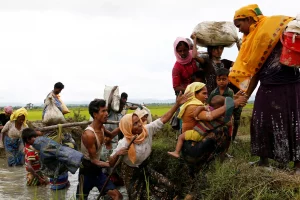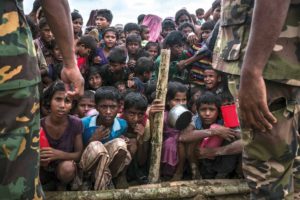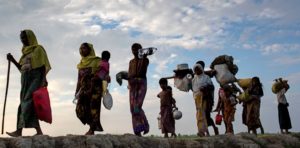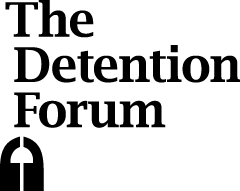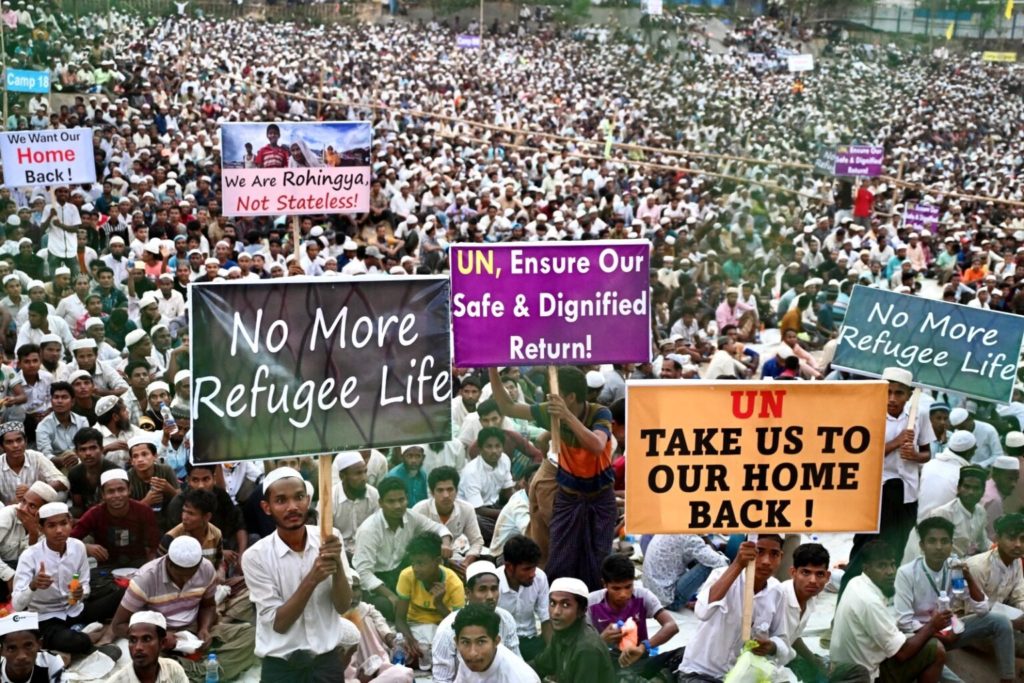
A recent high-level conference at the United Nations failed to chart a path to solve the Rohingya crisis, while the need for international commitment and a comprehensive approach is more acute than ever.
On September 30, the United Nations General Assembly held a special conference on the Rohingya in New York. Unlike other UN conferences, the meeting did not follow a well-defined preparatory process, and UN member states did not present a negotiated outcome.
The participants mostly listened to three-minute speeches from Rohingya participants (but not including refugees in Bangladesh), UN member states and agencies, and civil society organisations.
It is not clear what anybody took away from the event, and there was no time for genuine debate, except during some informal sideline events. Presentations by most delegations reflected existing findings and recommendations, and new perspectives were limited.
On the positive side, active international media engagement reminded the world of the Rohingya’s plight, and some government donors announced new financial contributions. There was also evidence of a growing understanding that support for Rohingya refugees in Bangladesh must shift from humanitarian relief to long-term solutions. Also, many acknowledged that the current situation in Rakhine State is not suitable for their immediate return.
Time will tell whether the conference becomes a starting point for greater international commitment to solving the Rohingya crisis. But can a one-day meeting turn into a process?
Rakhine has been engulfed in a bloody war between the Myanmar junta and the Arakan Army since November 2023. Blockades imposed by the Myanmar military regime, as well as its widespread use of indiscriminate artillery and airstrikes, are exacting a huge toll on civilians, and many have fled the state, while those who remain are struggling to survive.
The already dire situation along the Bangladeshi border has deteriorated further in recent months, as clashes between the AA and Rohingya armed groups, including the Arakan Rohingya Salvation Army and the Rohingya Solidarity Organisation, have increased.
The AA has accused both the Bangladesh Border Guard and the Myanmar junta of arming Rohingya militias and facilitating their attacks in northern Rakhine, while the Bangladeshi authorities and Rohingya militias accuse the AA of committing atrocities against Rohingya civilians.
In this context, the opportunities for dialogue that many in the UN conference hoped for are gradually slipping away.
Meanwhile, Bangladesh has often received praise for being a generous host of around 1.1 million Rohingya refugees. While gratitude is warranted, the government has implemented a policy of exclusion that keeps the Rohingya in highly securitised camps, banning them from employment and official education.
Bangladesh disappointed many at the UN conference with its refusal to lift these bans, which stands in the way of much needed sustainable solutions. Allowing the Rohingya to work would defray humanitarian costs and ensure that refugees acquire the skills and experience they will need upon their return to Rakhine.
There are also Rohingya in other countries, but they are usually ignored – and the UN conference was no different. According to a report by Doctors Without Borders, in 2024 the number of Rohingya around the world totalled 2.8 million. The four countries with the largest numbers of refugees were Bangladesh with 1.1 million, Pakistan with 400,000, Saudi Arabia with 340,000 and Malaysia with 210,000.
By ignoring this reality, the conference failed to acknowledge that the Rohingya crisis needs a variety of approaches. While in Bangladesh ultimate repatriation is the key priority, in countries with refugee flows from decades ago, such as Saudi Arabia and Pakistan, other solutions could be pursued, such as integration into host societies.
Meanwhile, there are several key issues that should be part of overall solutions for the Rohingya in Rakhine. These include equality before the law and citizenship for them, dispelling the “fog of war” in the conflict by distinguishing between true and false information, and the development of a comprehensive plan for the state.
Many speakers in New York stressed the importance of Myanmar citizenship for the Rohingya, but their interventions suggested a limited understanding of the complexity of the situation. For instance, who should grant them citizenship? The military junta, which has lost control of much of the country, the National Unity Government, or the AA?
Myanmar is an enormously diverse country, and the issue of citizenship is part of a wider, and still open, question of inclusion and equality for all.
Successive governments have used this diversity to divide the Myanmar population, while the debate on citizenship is virtually absent within the resistance movement, constituting a “blind spot” of the anti-junta camp, in the words of analyst Sai Latt. While younger generations are more open to dialogue, it lingers as a significant reluctance to openly discuss the issue among the general population.
The Federal Democracy Charter, a roadmap for transition to a new constitution, was adopted by the National Unity Consultative Council in 2021, and it continues to categorise people into two groups: officially recognised indigenous ethnic groups (or taingyinthar) and others – with differential rights.
Although the NUG initially hinted that it was prepared to accept citizenship for the Rohingya, its commitment appears to have faded. In 2024, the parallel government issued a joint position statement with allied organisations which includes the principle of “national equality”, but this suggests such an equality is reserved for officially accepted national groups.
It must be remembered that not only the Rohingya have been denied citizenship, but also other Muslim communities, Chinese, Hindus, Gurkhas, Sikhs, Anglo-Burmans and others. It is high time to explore collaboration with these groups and present the citizenship question in all its dimensions.
A more immediate problem is to know exactly what is going on in Rakhine. Suffering is obviously immense and atrocities are committed on a regular basis, but getting correct information is difficult amid conflict, displacement and telecommunications blockades. As often happens in such situations, deliberate disinformation thrives.
Linked to this “fog of war” is the question of victimhood. The fact that the Rohingya are victims is accepted around the world. But what about the other communities in the state, including the Rakhine majority or minorities like the Maramagyi, the Mro, the Kaman, the Hindus, the Chin and others? They too are victims. They too have had their villages bombed and burned, while thousands are displaced in areas with no access to aid.
The acknowledgement that all Rakhine populations have been victimised would be a first step toward reconciliation. It is also evident that there are different degrees of victimhood and destitution; this too must be acknowledged before any fruitful dialogue can take place.
Yet what is needed first are independent investigations into what has happened in northern Rakhine since the war resumed in November 2023, including allegations of atrocities committed by the Myanmar military, the AA and Rohingya militants. The AA’s recent invitation to Tom Andrews, the UN special rapporteur on human rights in Myanmar, to visit the country could be the start of a process toward a better understanding of what has been happening in northern Rakhine over the past two years.
It is also necessary to ascertain what has happened in the camps in Bangladesh: how did Rohingya militias manage to get a firm hold on the refugees? Where do their funding and weapons come from? And how is it possible that thousands of fighters managed to cross, seemingly unnoticed, the border to Rakhine?
Beyond that, a comprehensive plan for Rakhine is needed, focusing not only on humanitarian needs but also on addressing three major crises pertaining to security, economics and development, and human rights. This suggestion dates back to 2017, when the Advisory Commission on Rakhine State, headed by Kofi Annan, made it part of its recommendations.
To assist with the development of such a plan, the international community must move away from its traditional state-centric approach, which implies continued acceptance of Nay Pyi Taw’s military regime as its main interlocutor.
A good starting point would be pragmatic crossborder humanitarian support to the state, which requires full cooperation from Bangladesh. This support is not only urgently needed but is also in the interest of authorities on both sides of the border, and it would help to create the kind of stability and security needed to move forward.
Yet, adequate humanitarian support for the Rohingya camps in Bangladesh, and for the population in Rakhine, is only the beginning of a massive task. For now, the UN conference has not delivered better prospects for long-term assistance needed to equip Rohingya outside Myanmar with the kind of skills they will need on their return. It is also important for the Rohingya to unite and counter efforts to divide them.
About the author: Laetitia van den Assum is a former Netherlands ambassador. She was also a member of the Advisory Commission on Rakhine State (2016-2017).
The opinions expressed in this blog are those of the author and do not necessarily represent the views of United Against Inhumanity (UAI).
This article was previously published by Frontier Myanmar: https://www.frontiermyanmar.net/en/searching-for-solutions-for-the-rohingya/
